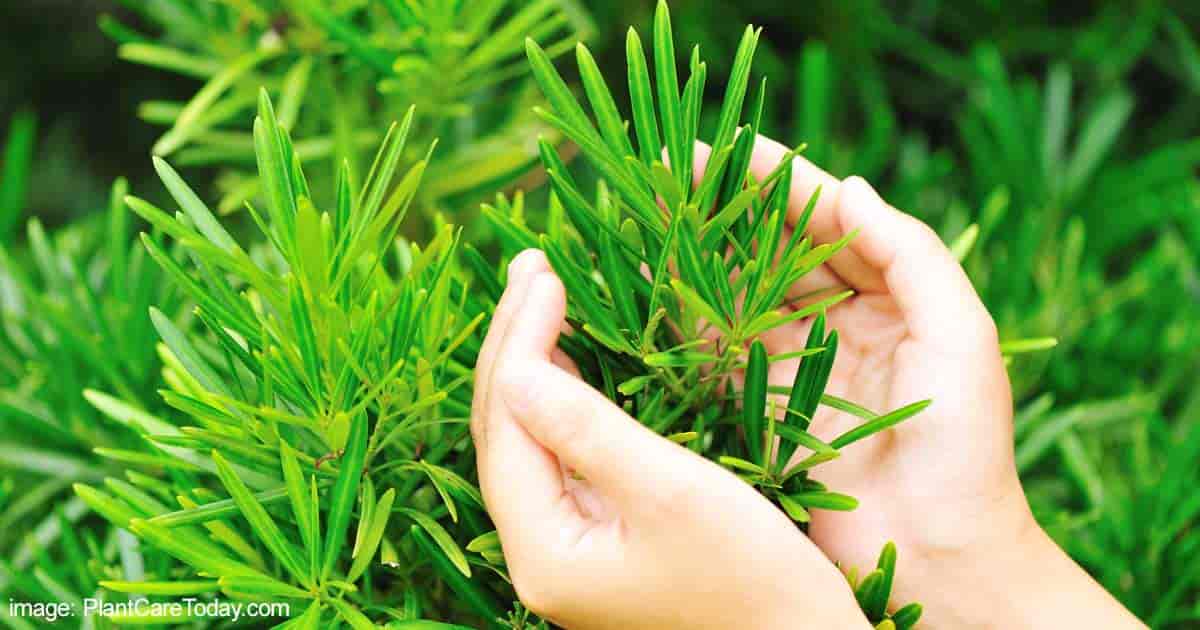Podocarpus macrophyllus pronounced [pod-oh-KAR-pus mak-roh-FIL-us] and has a few common names:
- Japanese yew
- Yew plum pine
- Buddhist pine
- Fern pine
- Arhat pine
- Yew podocarpus

This small-sized to medium-sized evergreen tree is native to southern Japan and southern China.
It’s also the state tree of Chiba Prefecture in Japan.
The yew plum pine belongs to the large family Podocarpaceae, comprised mostly of other conifers.
Other conifers include various pines, spruces, larches, and cedars.
Approximately 75 other species reside in the genus, many used as ornamentals and indoor houseplants.
It’s a popular plant that grows just about anywhere, but there are some steps to follow for optimal growth.
Podocarpus Care
Size and Growth
The yew podocarpus plants can get quite large growing outdoors. In its native region, it may reach up to 20 meters.
When growing indoors, it’s slow growth rate eventually produces a small tree reaching six feet tall.
Podocarpus macrophyllus grows from one long central stem producing a series of short branches with clusters of soft dark green leaves.
The dense clusters make the plant look like a large fern pine plant. The yew pine leaves are typically about two to four inches.
Flowering and Fragrance
Podocarpus tree is not grown for its flowers, as it rarely blooms. Older female plants eventually start bearing fruit and flowers.
The bloom time of their catkin-like inflorescences is in the spring. The plump red fruit contains seeds considered toxic to people and pets.
Light and Temperature
Plant the tree outdoors in slightly acidic, well-drained soil. It should get full sun to partial shade.
If grown indoors, it shouldn’t get direct sunlight. Avoid placing it in a south-facing window.

Podocarpus macrophyllus plants are recommended for USDA hardiness zones 7 to 11, which covers most of North America, except the dryer south.
In warm regions, it does best in full sun with some part shade during the day.
The plant can tolerate freezing temperatures through part of winter, but if temperatures are severely cold, it should be brought indoors.
Watering and Feeding
Water yew pines regularly throughout the spring, summer, and fall.
The plant shouldn’t be allowed to dry out. Keep the soil damp, but never too soggy.
During the winter, limit the frequency of watering and don’t fertilize.
During the active growing season, fertilizer may be added once per month with the water.
Soil and Transplanting
Regular potting soil should provide adequate drainage and nutrients for this hardy plant. If planted in the ground, the soil should be slightly acidic.
TIP: As it requires moist conditions during the active growing season, adding pebbles to the bottom of the pot helps prevent mildew and mold growth.
As the plant grows, transplanting may be needed. If the plant starts to outgrow its pot, transplant it in early spring with fresh soil.
Grooming and Maintenance
Grooming helps keep the yew pine tree from taking over the room when grown indoors or outdoors.
Trim back the foliage as needed to manage the growth or prune into topiary shapes.

Propagating Podocarpus Macrophyllus
Propagate these specimens by taking cuttings in the fall.
Consider using shoot tips when trimming back the plant when grooming.
The cuttings should be slightly woody, dipped and the base coated with a rooting hormone.

Plant them in small pots or a tray. If possible, the young specimens should be set over heat.
The cuttings don’t need to be covered with plastic. Set them in an area with plenty of sunlight and ensure that the soil doesn’t completely dry out.
Podocarpus macrophyllus should take root during the winter and start growing in the spring.
Podocarpus Pests or Disease Problems
The fern pine hedge is a hardy plant, but there are a few dangers, including a potential danger to people and pets.
As mentioned, parts of the plant are toxic.
The fruits, stems, and foliage is toxic causing severe vomiting and diarrhea when consumed. To be safe, keep this plant away from young children and pets.

While this plant prefers moist soil, it shouldn’t be overwatered, which is the most common issue. It does not like wet soil.
If the soil is soggy, allow the soil to dry out.
Alkaline soils produce yellow leaves
Pests are rarely a problem for this plant. However, plant scale, whiteflies, and aphids do attack.
If aphids attack, try blasting them with a spray of water. For all severe infestations, use an insecticide like neem oil.
Uses For Podocarpus Macrophyllus
This plant can grow almost anywhere, indoors or outdoors. While it’s suited for most regions and environments, it does grow large.
Use younger specimens to bring more color to porches or balconies.
Older plants may be grown outdoors for privacy hedges, and foundation planting. Disney World in Orlando uses potted P. macrophyllus as movable hedges in full sun to hide ‘work in progress.’

In California, these plants are grown in large containers for use in the landscape.
Give plants plenty of space and prune to maintain shape.
